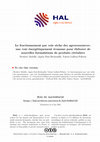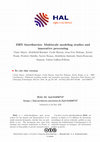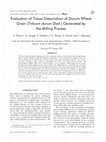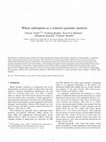Papers by frederic mabille
Projet scientifique de l'équipe SiS dans le cadre de la restructuration de l'UMR IAT

17. Convention d'affaires des procédés industriels et services destinés à l'ensemble des acteurs du secteur agroalimentaire - ProFood 2010, Jun 22, 2010
Le fractionnement par voie sèche des agroressources : Une voie énergétiquement économe pour élabo... more Le fractionnement par voie sèche des agroressources : Une voie énergétiquement économe pour élaborer de nouvelles formulations de produits céréaliers Le fractionnement par voie sèche des agro-ressources. Bilan énergétique d'une opération de broyage. Approche multi échelle de la cohésion. Apport de la simulation numérique. Conclusions Le fractionnement par voie sèche des agro-ressources. Bilan énergétique d'une opération de broyage. Approche multi échelle de la cohésion. Apport de la simulation numérique. Conclusions Le fractionnement par voie sèche des agro-ressources. Bilan énergétique d'une opération de broyage. Approche multi échelle de la cohésion. Apport de la simulation numérique. Conclusions Broyage par impact Broyage par cisaillement Séparation Agro-ressources Fragmentation + Dissociation Agro ressources Sous produits Opération énergivore [Schönert,1988 ] Reconception de l'opération-enjeu économique et environnemental-Séparation granulométrique Séparation aérodynamique Coproduits Fractions Le fractionnement par voie sèche des agro-ressources. Bilan énergétique d'une opération de broyage. Approche multi échelle de la cohésion. Apport de la simulation numérique. Conclusions micromoulin à cylindres instrumentés Le fractionnement par voie sèche des agro-ressources. Bilan énergétique d'une opération de broyage. Approche multi échelle de la cohésion. Apport de la simulation numérique. Conclusions " Utilisation de prétraitements physiques ou biochimiques Nécessité d'une approche pluridisciplinaire Nécessité d'une approche multi-échelle Description des opérations unitaires Compréhension des mécanismes de cohésion Confrontation des approches et améliorations des modèles de simulation Le fractionnement par voie sèche des agro-ressources. Bilan énergétique d'une opération de broyage. Approche multi échelle de la cohésion. Apport de la simulation numérique. Conclusions

The composition and the structure of biomass makes it a wonderful source of raw materials for the... more The composition and the structure of biomass makes it a wonderful source of raw materials for the production of energy or bio based material. As examples, the most inner part (the pith) of corn stalk,an agricultural by-product, shows an alveolar structure, similar to those of expanded polystyrene, responsible of insulating properties [1][2]. On other example are the vascular bundles of the pith and the ring, which also insure, a mechanical support for the plant, making them particularly interesting for reinforcement of composite materials. One of the challenges is to recover each plant part without damaging its structure to preserve the original properties. This can be achieve by dry fractionation processes, which allow to dissociate plant structures at the relevant scale, between 0.5-4mm. Dry fractionation diagram combining grinding (based on shearing solicitation) and separation step (based on size and density) have been developed at the kilogram scale in order to separate the rin...
HAL is a multi-disciplinary open access archive for the deposit and dissemination of scientific r... more HAL is a multi-disciplinary open access archive for the deposit and dissemination of scientific research documents, whether they are published or not. The documents may come from teaching and research institutions in France or abroad, or from public or private research centers. L’archive ouverte pluridisciplinaire HAL, est destinée au dépôt et à la diffusion de documents scientifiques de niveau recherche, publiés ou non, émanant des établissements d’enseignement et de recherche français ou étrangers, des laboratoires publics ou privés. Impact of new tool development to study wheat grain fractionation and control the product quality Valerie Lullien-Pellerin, Joel Abecassis, Claire Desvignes, Agnès Duri, Valerie Greffeuille, Youna Hemery, Frederic Mabille, Milena Martelli, Gisela Rios, Xavier Rouau, et al.
order to produce food ingredients that will be the base of a large number of cereal-based food pr... more order to produce food ingredients that will be the base of a large number of cereal-based food products.Dry milling was optimized in the past to extract energetic compounds of grains (starch, protein)recovered in refined flour/semolina from which almost all fibres and micronutrients are discarded.Conventional milling processes can be revisited to produce flours enriched in these components ofinterest. Moreover, innovative technologies, such as cryogeny or electrostatic separation, are underinvestigations to produce new food ingredients either from wheat grains or brans (coming fromconventional milling).
HAL is a multi-disciplinary open access archive for the deposit and dissemination of scientific r... more HAL is a multi-disciplinary open access archive for the deposit and dissemination of scientific research documents, whether they are published or not. The documents may come from teaching and research institutions in France or abroad, or from public or private research centers. L’archive ouverte pluridisciplinaire HAL, est destinée au dépôt et à la diffusion de documents scientifiques de niveau recherche, publiés ou non, émanant des établissements d’enseignement et de recherche français ou étrangers, des laboratoires publics ou privés.

Le fractionnement joue un role cle dans la transformation et les usages des grains de ble tendre ... more Le fractionnement joue un role cle dans la transformation et les usages des grains de ble tendre puisqu'il permet de moduler la composition et les proprietes des ingredients pour la fabrication des aliments cerealiers. Pour repondre aux enjeux de la filiere, des chercheurs de l'equipe « Fractionnement des Agro-ressources» de l'UMR IATE s'attache a mieux comprendre les relations entre les caracteristiques des lots de ble et la qualite des fractions. Ces dernieres annees, differents travaux ont permis notamment de : (i) suivre la distribution des differentes parties du grain au cours des procedes via le developpement de marqueurs originaux et plus specifiques que les cendres ; (ii) montrer l'influence des facteurs genetiques et environnementaux sur le rendement meunier et la qualite des farines ; (iii) developper des methodes innovantes de fractionnement a l'echelle sub-cellulaire. Ces avancees ouvrent la voie a un meilleur controle du rendement meunier et de l...

Innovative Food Science & Emerging Technologies, 2017
This paper reviews studies on green resource fractionation for two different types of material di... more This paper reviews studies on green resource fractionation for two different types of material displaying a lignocellulosic or granular-type structure or a composite of the two. It explains how the identification of specific biochemical or spectral markers helps monitor tissue fate along processing and thus increase our knowledge on material fractionation. The key role of tissue mechanical properties in fracture behavior and the value of characterizing them were highlighted to better understand particle composition and properties. The effect of different modes of mechanical stress and strain during grinding as the main step of fractionation was illustrated. The value of different types of pre-treatment before or at grinding to reduce energy required to fracture and enhance dissociation or compound accessibility was presented. Separation methods based on differences in properties of the generated particles, and particularly innovative developments based on electrostatic sorting, were reviewed.
Innovative Food Science & Emerging Technologies, 2017
Designing and processing complex matter and materials are key objectives of bioresource and biopr... more Designing and processing complex matter and materials are key objectives of bioresource and bioproduct research. Modeling approaches targeting such systems have to account for their two main sources of complexity: their intrinsic multi-scale nature; and the variability and heterogeneity inherent to all living systems. Here we provide insight into methods developed at the
The "Virtual Grain" project has a double objective: the first one is to gather in a dat... more The "Virtual Grain" project has a double objective: the first one is to gather in a data warehouse heterogeneous information concerning the properties of cereal grains (morphology, biochemistry, etc.) and the conditions in which these data were obtained; the second one is to use this data warehouse in order to obtain a cartography of grain properties that consists in a three-dimension mesh grid, and to identify potential relationships between these various properties.
Traffic and Granular Flow ’07, 2009
We analyze stress transmission in granular media involving an interstitial cementing matrix of va... more We analyze stress transmission in granular media involving an interstitial cementing matrix of variable volume fraction. We rely on a lattice-type discretization of both the particles and cemented matrix. We show that the stress chains are essentially guided by the cementing matrix in tension and by the particulate backbone in compression. The signature of granular structure appears clearly on the
Pour pouvoir contrôler la composition et les propriétés des fractions générées par la mouture, il... more Pour pouvoir contrôler la composition et les propriétés des fractions générées par la mouture, il est essentiel de déterminer les relations entre la structure des grains et le devenir des tissus lors des procédés. Le développement d'outils de mesure des propriétés mécaniques des grains ou des tissus, ainsi que les outils de modélisation, permettent d'identifier les caractéristiques impliquées dans les différents modes observés de fractionnement et de développer des modèles prédictifs. Une base de données a été construite pour mettre en relation des résultats issus de champs disciplinaires différents et acquis à des niveaux d'échelles distincts.

Journal of Food Engineering, 2010
ABSTRACT Wheat bran is currently an undervalued by-product, and could be processed into food ingr... more ABSTRACT Wheat bran is currently an undervalued by-product, and could be processed into food ingredients with high nutritional potential. The aim of this study was to determine the influence of bran moisture content, and the influence of sub-zero temperatures on the mechanical properties of whole bran layers and hand isolated bran tissues (outer pericarp, intermediate layer, aleurone layer), to get information on their potential breakage behavior during fractionation processes and determine the most suitable working conditions to develop efficient processes. The mechanical properties of bran strips were assessed by stress–strain tests using a dynamic mechanical thermal analyzer, with temperature control and relative humidity control. This work showed that it is possible to modulate the mechanical properties of bran samples by modifying their moisture content and the temperature. The extensibility (ultimate strain) of bran tissues was positively correlated to their moisture content (from 9% to 21%, w.b.) and to the temperature (from −100 to 25°C), whereas their stiffness (Young modulus) was negatively correlated to these parameters. In certain conditions, the constitutive layers of whole bran strips broke at different locations, showing that these layers could be dissociated. At temperatures of −50°C and below, whole bran and intermediate layers seemed to lose their plasticity. This phenomenon could be linked to a small glass transition detected between −40 and −50°C in the intermediate layer. These results may allow adapting fractionation processes for a better use of bran.

Journal of Cereal Science, 2010
ABSTRACT The wheat grain is surrounded by a multilayered system composed of different tissues dif... more ABSTRACT The wheat grain is surrounded by a multilayered system composed of different tissues differing in their composition and mechanical properties. Up to now, these properties have been determined using classical tensile tests. However no methodology exists to evaluate the inter-tissular adherence. With this purpose, a micromechanical device adapted to wheat tissue (5 tissues with thickness varying from 2 to 55 μm) was built in order to investigate an interface of industrial interest for wheat processing (between the aleurone layer and the nucellar epidermis). Taking into account the complexity of the peel force measured, the stored elastic energy on the peel arms was estimated using tensile tests of peel arms and was found to approximate 0.15% of the total peel force at low peel rates. The energy dissipated was investigated as a function of peel test parameters (angle, curvature radius and rate), and seems to have a minimal influence when low peel rates were applied (20 μm s−1). The peel test was finally used to investigate the adherence distribution around the wheat grain using samples dissected in different directions. The bottom of the grain was the least adherent region, whereas the top of the grain towards the brush was the most adherent region. Even though the interpretation of the peel force was complex, this technique could be appropriate to evaluate the adherence within natural biological tissues.

Journal of Cereal Science, 2002
The three major botanical components (starchy endosperm, aleurone layer and pericarp) of eight du... more The three major botanical components (starchy endosperm, aleurone layer and pericarp) of eight durum wheat samples exhibited signi®cantly different compositions and concentrations in phenolic acids. The starchy endosperm, the aleurone layer and the pericarp were respectively characterised by a low content in ferulic acid (FA), a high content in trans-sinapic acid (t-SA), and a high content in ferulic acid dehydrodimers (DHD). These three chemical markers can be exploited to differentiate the three grain botanical parts within milling fractions and to evaluate the milling ef®ciency, particularly the separation between bran and endosperm. The histological dissociation of the wheat grain generated by the milling process can be investigated further into details using the three phenolic acids markers. A separability index (Si) was proposed in order to quantify the ease of dissociation of endosperm from bran. Differences in Si values between wheat varieties grown under various agricultural conditions demonstrated the relevant variability of this character. The structural and molecular factors implied in the control of tissue dissociation are discussed in details.

Journal of Cereal Science, 2008
We introduce a cohesive granular model of the wheat endosperm involving a discrete phase composed... more We introduce a cohesive granular model of the wheat endosperm involving a discrete phase composed of starch granules, a continuous phase representing the protein matrix and pores. The cohesion of the texture is governed by adherence between starch and protein, reflecting the biochemical nature of the interface, and the protein content that controls the connectivity between starch granules. We present a detailed parametric study of the stiffness, yield strength and regimes of crack propagation under tensile loading. We then show that starch damage, as a descriptor of wheat hardness, scales with the relative toughness between the starch and the starch-protein interface. The toughness appears therefore to be the control parameter governing transition from 'soft' to 'hard' behavior. Interestingly, this parameter combines the starch-protein adherence with protein content, two major quantities often assumed to underly wheat hardness.

Journal of Agricultural and Food Chemistry, 2003
The mechanical properties of wheat bran and the contribution of each constitutive tissue on overa... more The mechanical properties of wheat bran and the contribution of each constitutive tissue on overall bran properties were determined on a hard wheat (cv. Baroudeur) and a soft wheat (cv. Scipion). Manual dissection allowed three different layers to be separated from wheat bran, according to radial and longitudinal grain orientations, which were identified by confocal laser scanning microscopy as outer pericarp, an intermediate strip (comprising inner pericarp, testa, and nucellar tissue), and aleurone layer, respectively. Tissue microstructure and cell wall composition were determined. Submitted to traction tests, whole bran, intermediate, and aleurone layers demonstrated elastoplastic behavior, whereas pericarp exhibited elastic behavior. By longitudinal orientation, pericarp governed 50% bran elasticity (elastic strength and rigidity), whereas, in the opposite orientation, bran elastic properties were mostly influenced by the other tissues. Regardless of test orientation, the linear force required to bran rupture corresponded to the sum of intermediate and aleurone layer strengths. According to radial orientation, the intermediate strip governed bran extensibility, but according to longitudinal orientation, all tissues contributed until bran disruption. Tissues from both wheat cultivars behaved similarly. A structural model of wheat bran layers illustrated the detachment of pericarp from intermediate layer within radial bran strips.

The European Physical Journal E, 2007
Cemented granular materials (CGMs) consist of densely packed solid particles and a pore-filling s... more Cemented granular materials (CGMs) consist of densely packed solid particles and a pore-filling solid matrix sticking to the particles. We use a sub-particle lattice discretization method to investigate the particle-scale origins of strength and failure properties of CGMs. We show that jamming of the particles leads to highly inhomogeneous stress fields. The stress probability density functions are increasingly wider for a decreasing matrix volume fraction, the stresses being more and more concentrated in the interparticle contact zones with an exponential distribution as in cohesionless granular media. Under uniaxial loading, pronounced asymmetry can occur between tension and compression both in strength and in the initial stiffness as a result of the presence of bare contacts (with no matrix interposed) between the particles. Damage growth is analyzed by considering the evolution of stiffness degradation and the number of broken bonds in the particle phase. A brutal degradation appears in tension as a consequence of brittle fracture in contrast to the more progressive nature of damage growth in compression. We also carry out a detailed parametric study in order to assess the combined influence of the matrix volume fraction and particle-matrix adherence. Three regimes of crack propagation can be distinguished corresponding to no particle damage, particle abrasion and particle fragmentation, respectively. We find that particle damage scales well with the relative toughness of the particle-matrix interface with respect to the particle toughness. This relative toughness is a function of both matrix volume fraction and particle-matrix adherence and it appears therefore to be the unique control parameter governing transition from soft to hard behavior.
Uploads
Papers by frederic mabille